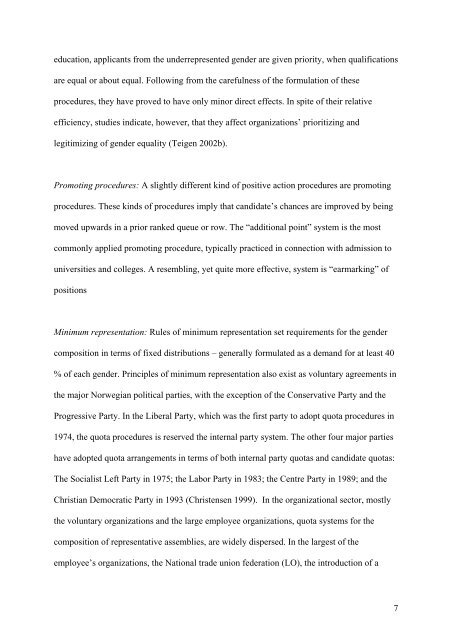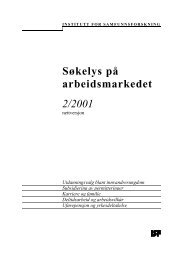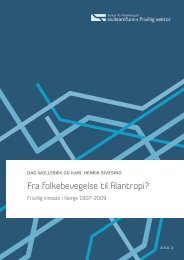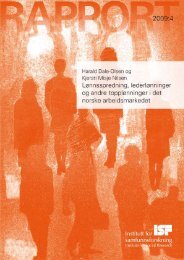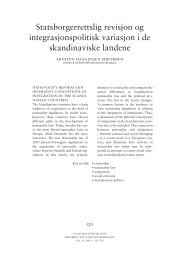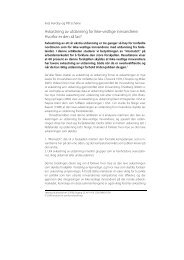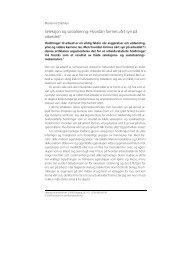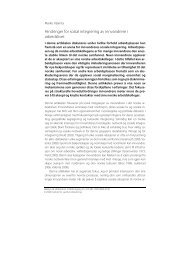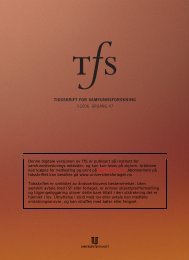Women in decision-making: The Norwegian Paradox
Women in decision-making: The Norwegian Paradox
Women in decision-making: The Norwegian Paradox
Create successful ePaper yourself
Turn your PDF publications into a flip-book with our unique Google optimized e-Paper software.
education, applicants from the underrepresented gender are given priority, when qualifications<br />
are equal or about equal. Follow<strong>in</strong>g from the carefulness of the formulation of these<br />
procedures, they have proved to have only m<strong>in</strong>or direct effects. In spite of their relative<br />
efficiency, studies <strong>in</strong>dicate, however, that they affect organizations’ prioritiz<strong>in</strong>g and<br />
legitimiz<strong>in</strong>g of gender equality (Teigen 2002b).<br />
Promot<strong>in</strong>g procedures: A slightly different k<strong>in</strong>d of positive action procedures are promot<strong>in</strong>g<br />
procedures. <strong>The</strong>se k<strong>in</strong>ds of procedures imply that candidate’s chances are improved by be<strong>in</strong>g<br />
moved upwards <strong>in</strong> a prior ranked queue or row. <strong>The</strong> “additional po<strong>in</strong>t” system is the most<br />
commonly applied promot<strong>in</strong>g procedure, typically practiced <strong>in</strong> connection with admission to<br />
universities and colleges. A resembl<strong>in</strong>g, yet quite more effective, system is “earmark<strong>in</strong>g” of<br />
positions<br />
M<strong>in</strong>imum representation: Rules of m<strong>in</strong>imum representation set requirements for the gender<br />
composition <strong>in</strong> terms of fixed distributions – generally formulated as a demand for at least 40<br />
% of each gender. Pr<strong>in</strong>ciples of m<strong>in</strong>imum representation also exist as voluntary agreements <strong>in</strong><br />
the major <strong>Norwegian</strong> political parties, with the exception of the Conservative Party and the<br />
Progressive Party. In the Liberal Party, which was the first party to adopt quota procedures <strong>in</strong><br />
1974, the quota procedures is reserved the <strong>in</strong>ternal party system. <strong>The</strong> other four major parties<br />
have adopted quota arrangements <strong>in</strong> terms of both <strong>in</strong>ternal party quotas and candidate quotas:<br />
<strong>The</strong> Socialist Left Party <strong>in</strong> 1975; the Labor Party <strong>in</strong> 1983; the Centre Party <strong>in</strong> 1989; and the<br />
Christian Democratic Party <strong>in</strong> 1993 (Christensen 1999). In the organizational sector, mostly<br />
the voluntary organizations and the large employee organizations, quota systems for the<br />
composition of representative assemblies, are widely dispersed. In the largest of the<br />
employee’s organizations, the National trade union federation (LO), the <strong>in</strong>troduction of a<br />
7


